General, Sir John Monash, Personal Files Book 22, 2 January - 1 February 1919- Part 6
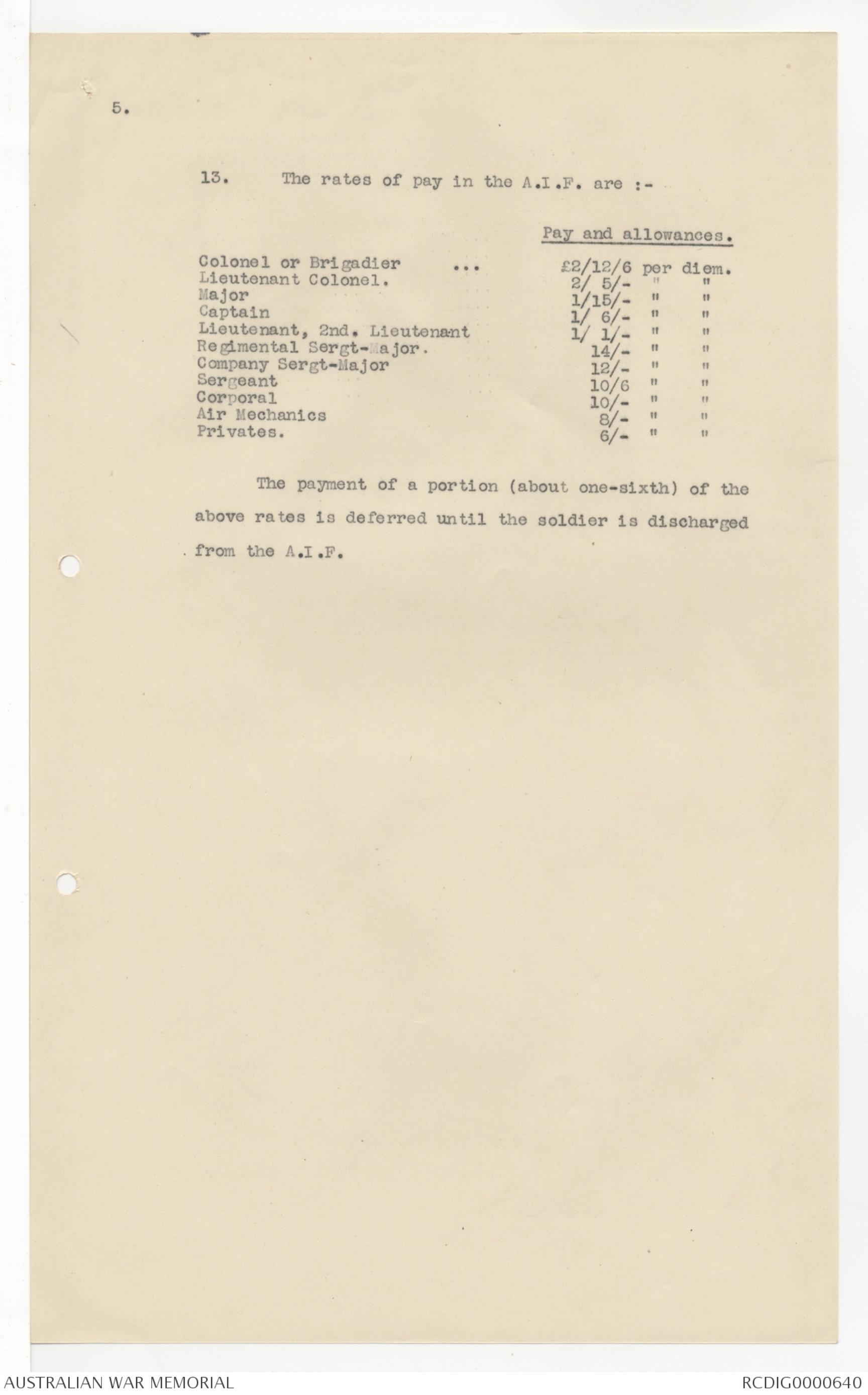
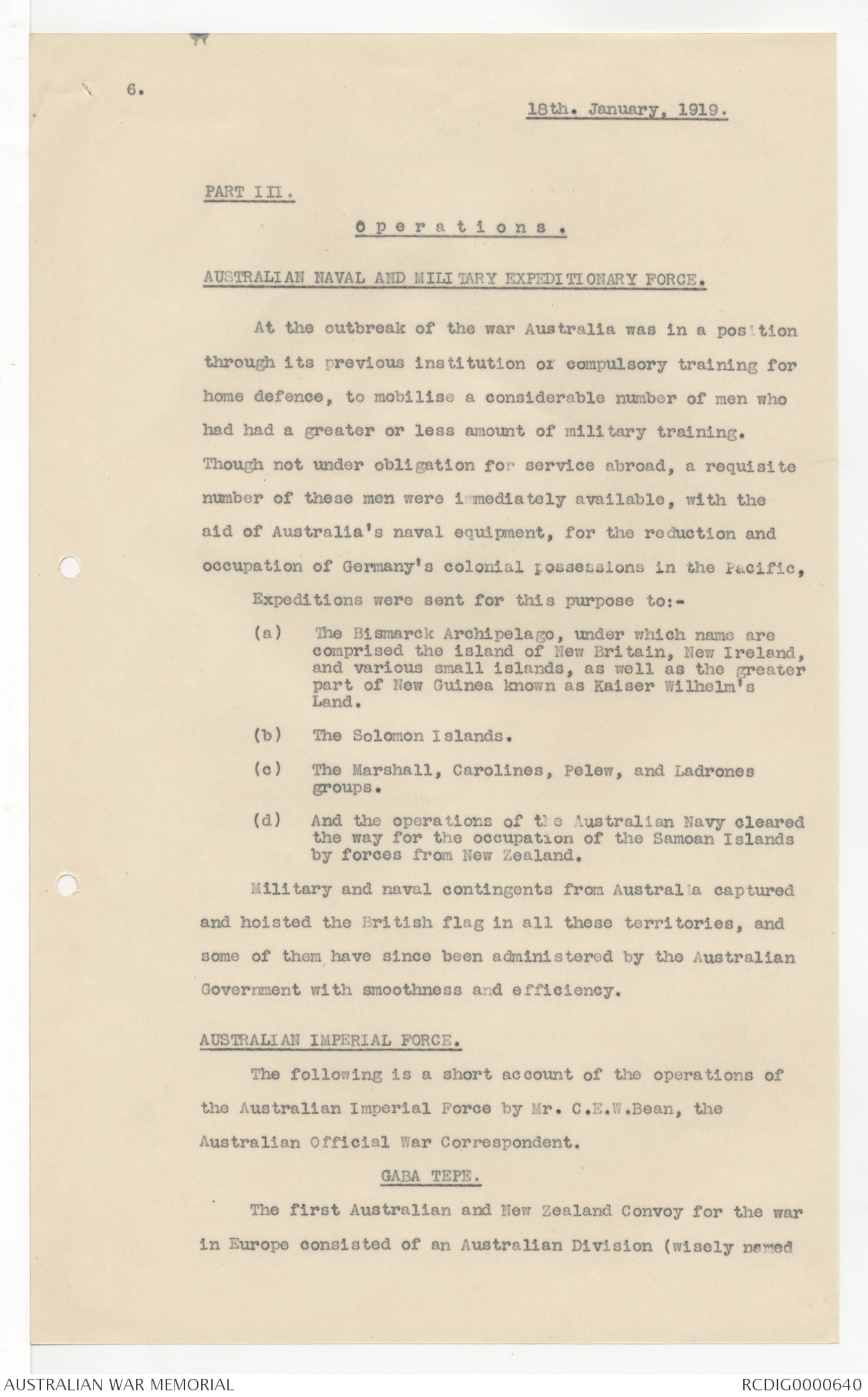
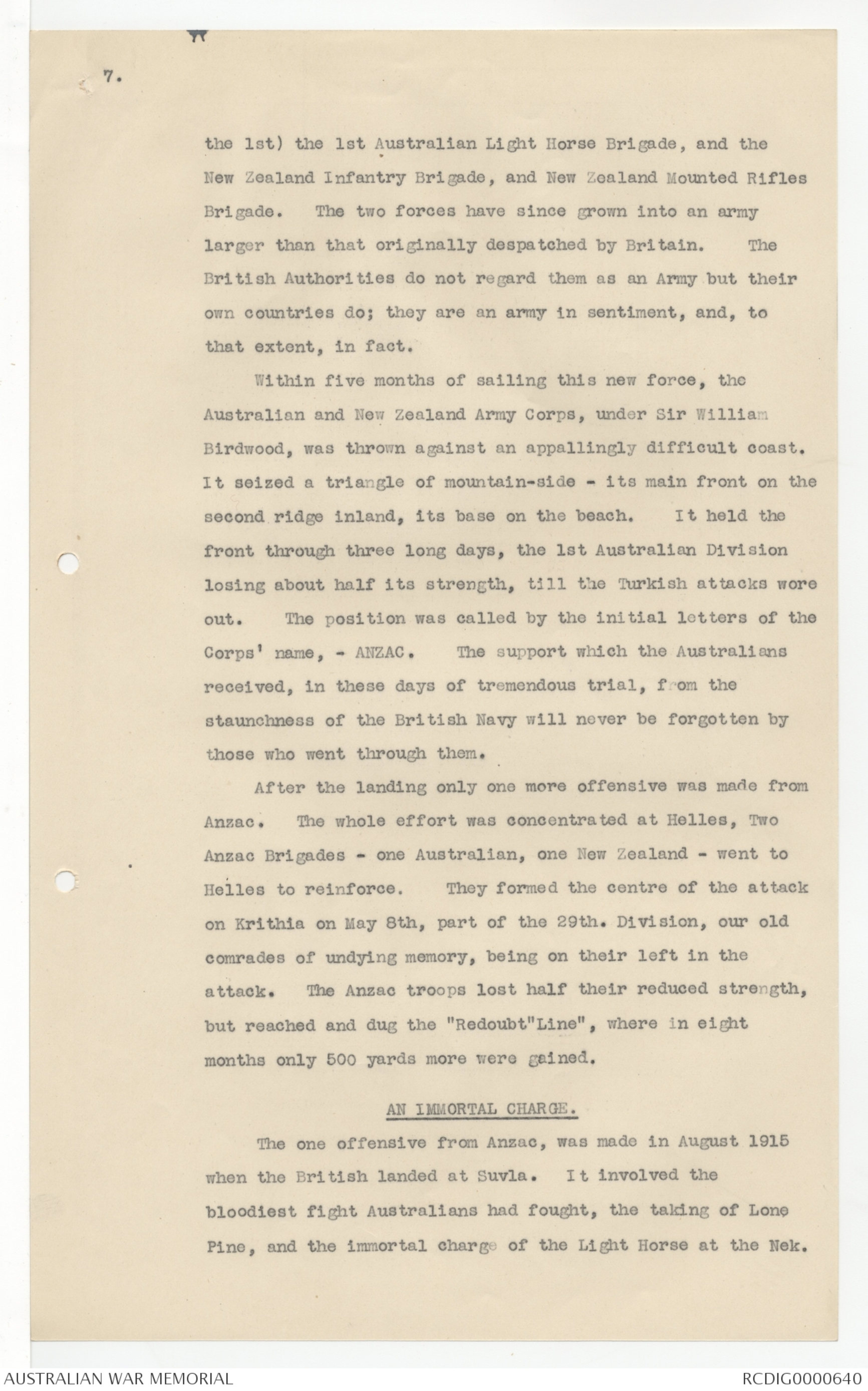
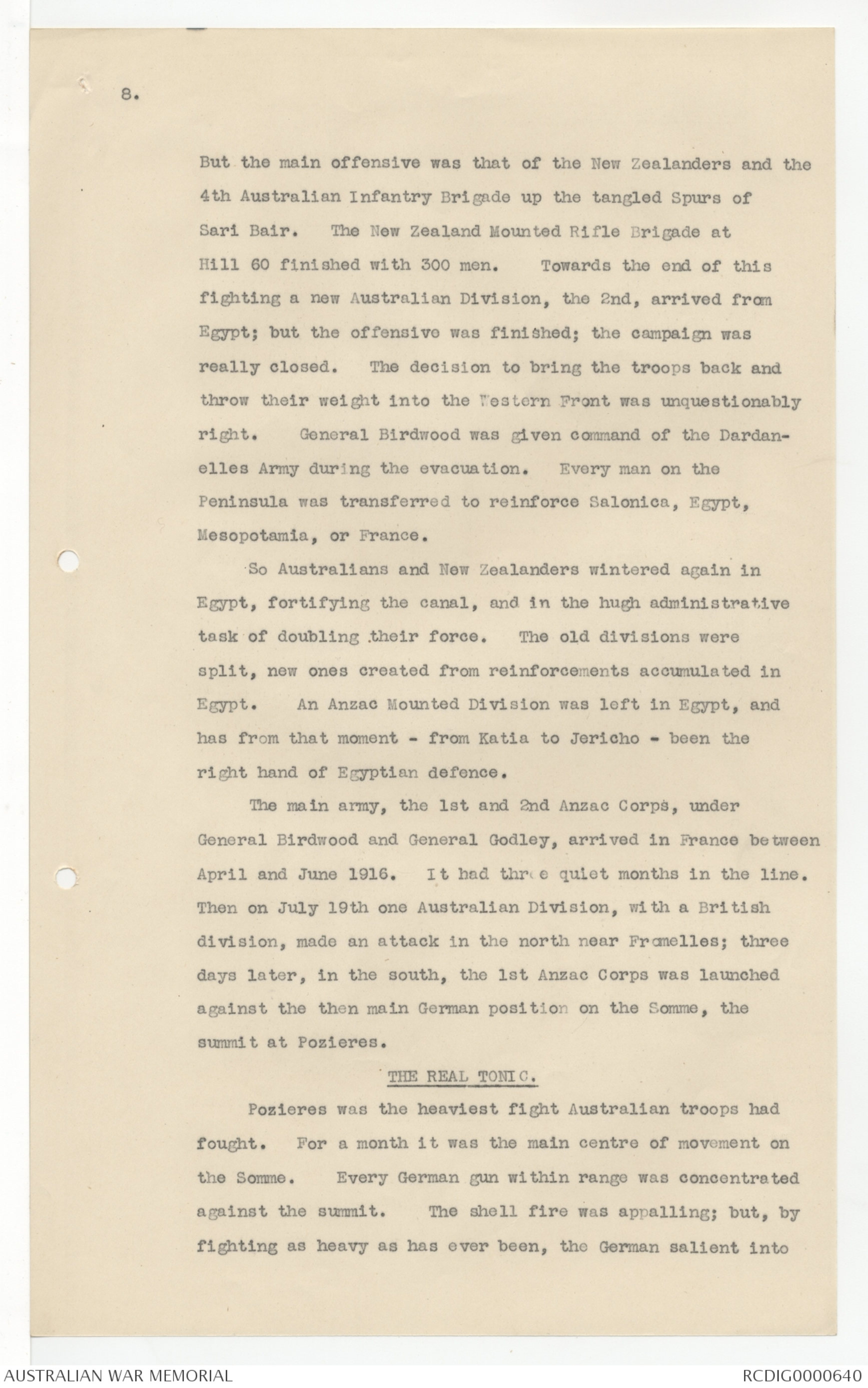
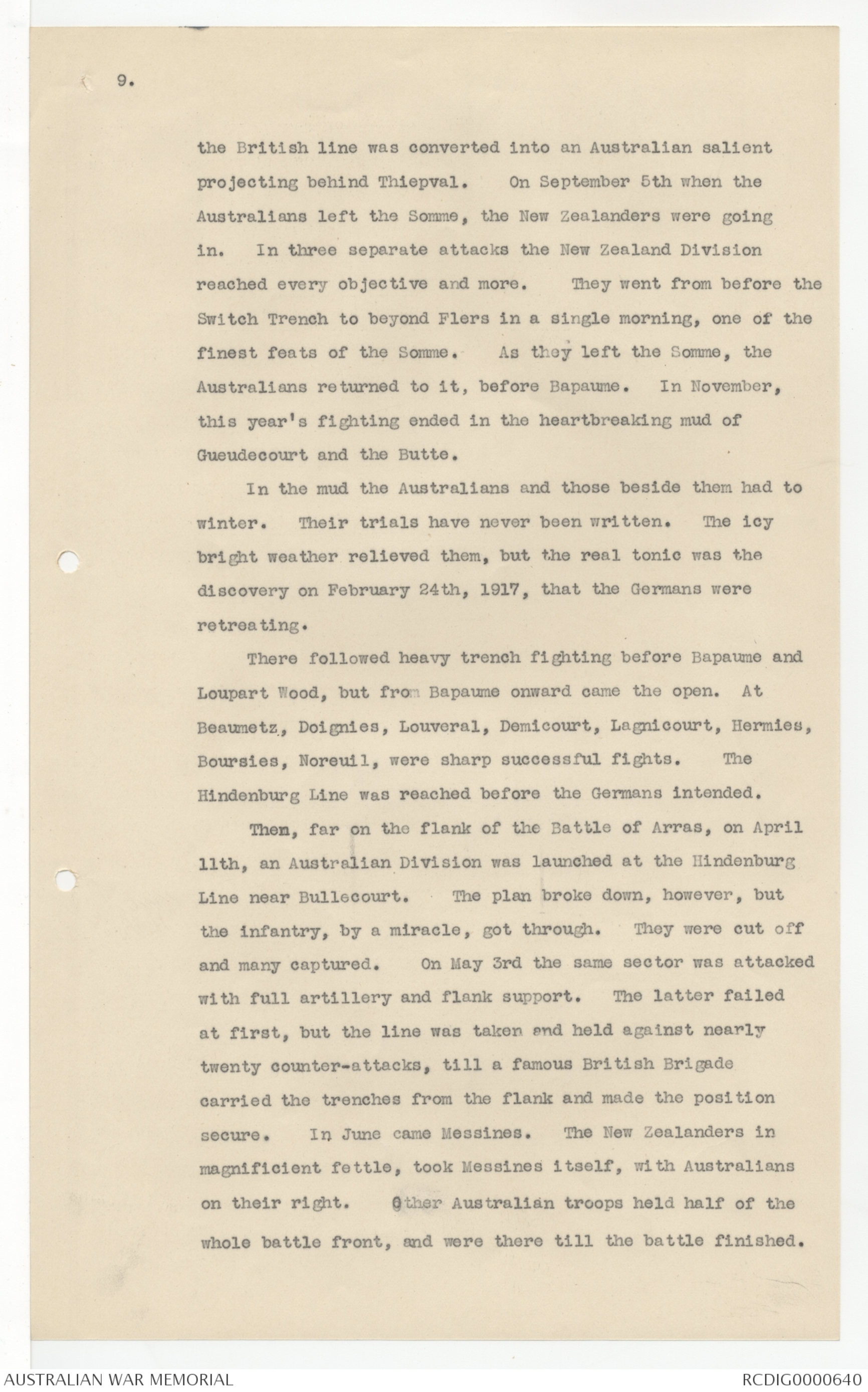
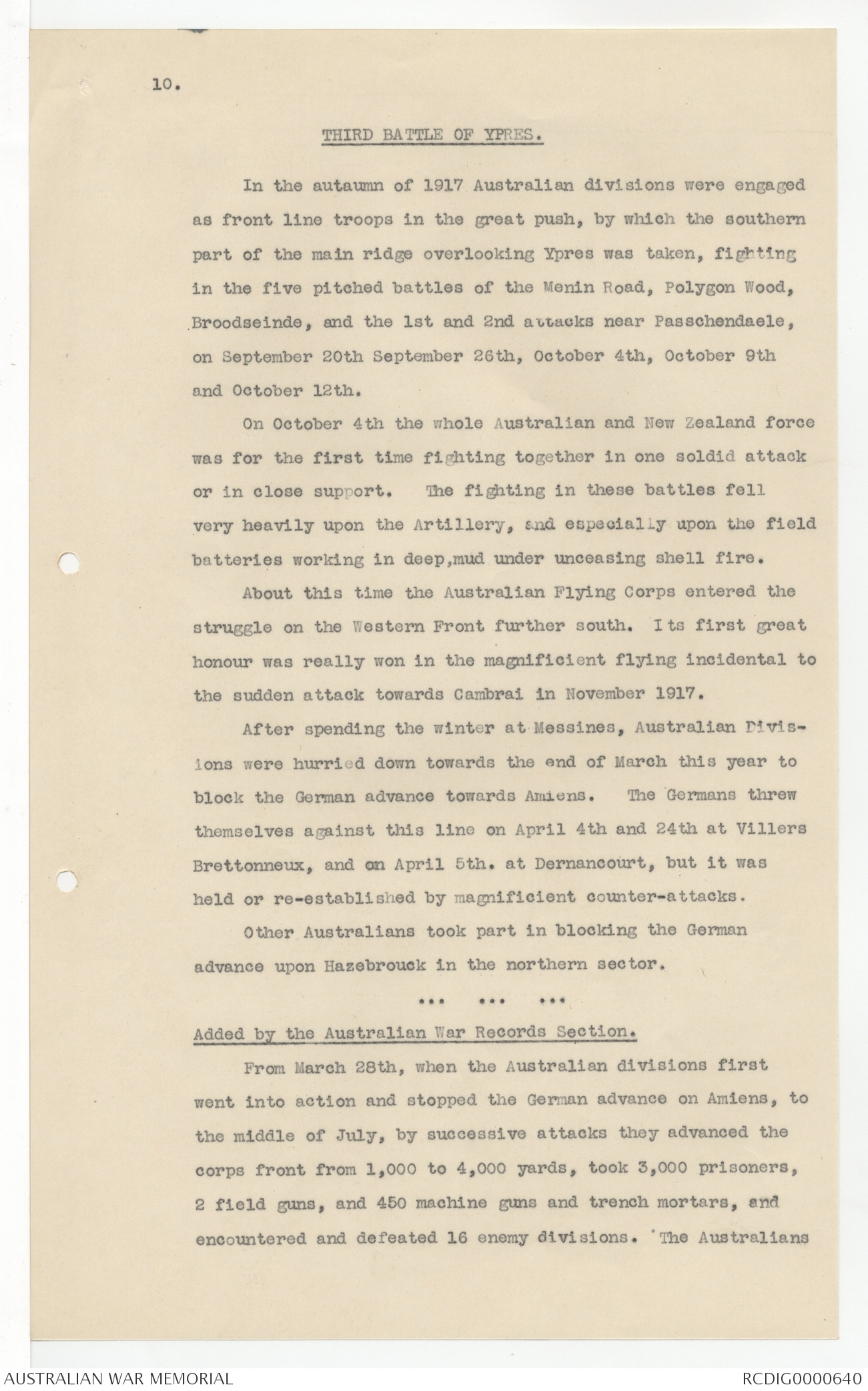
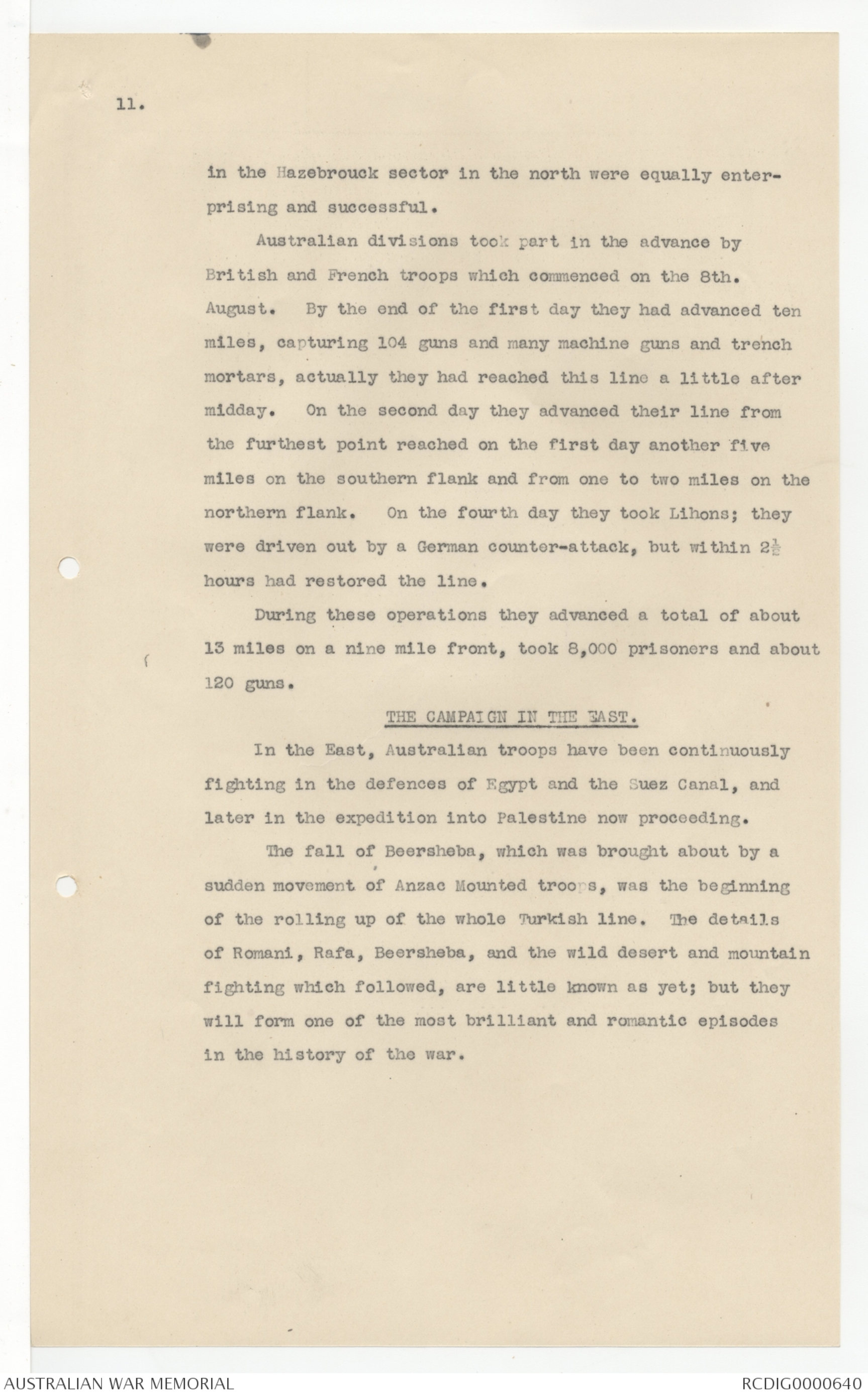

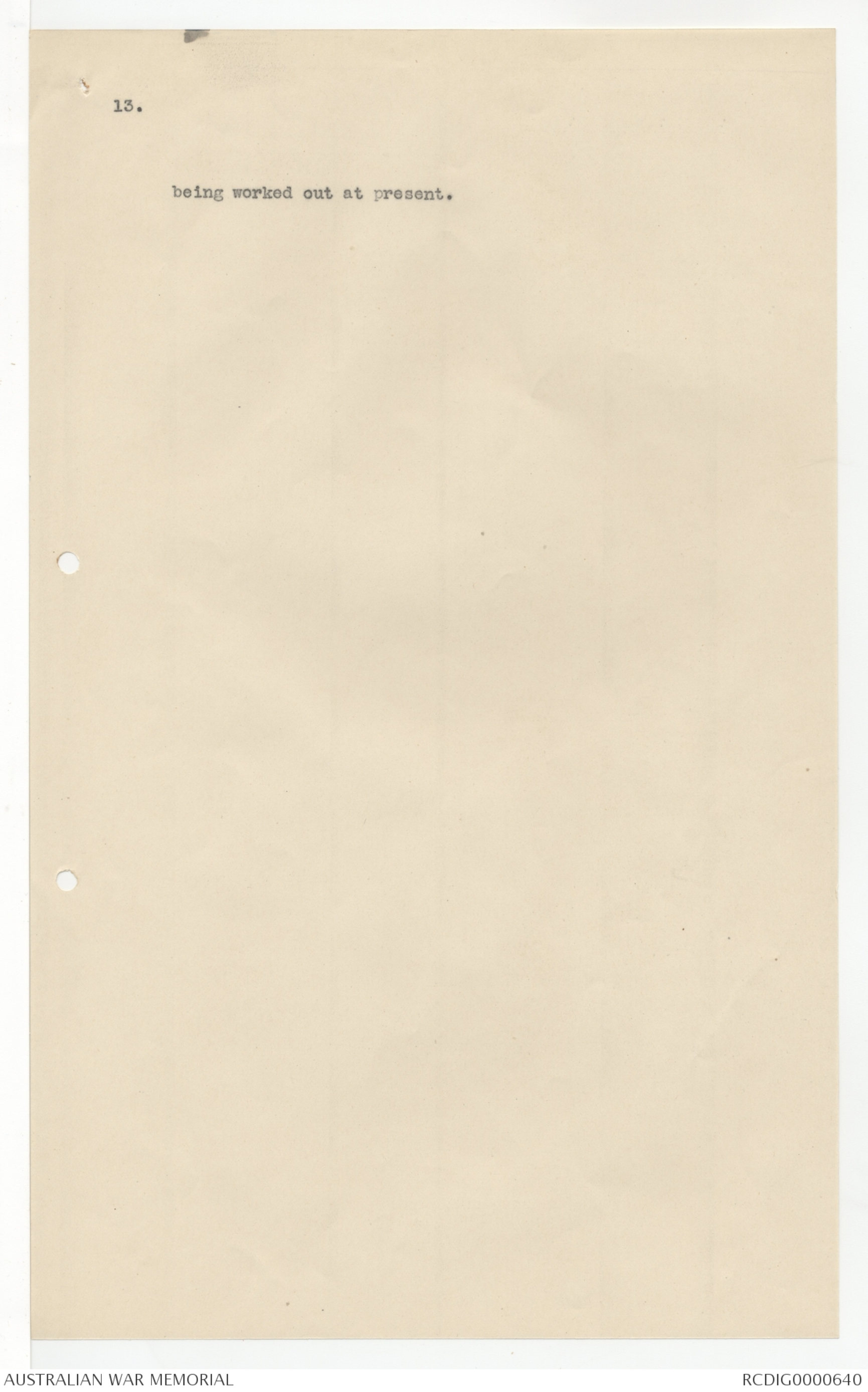
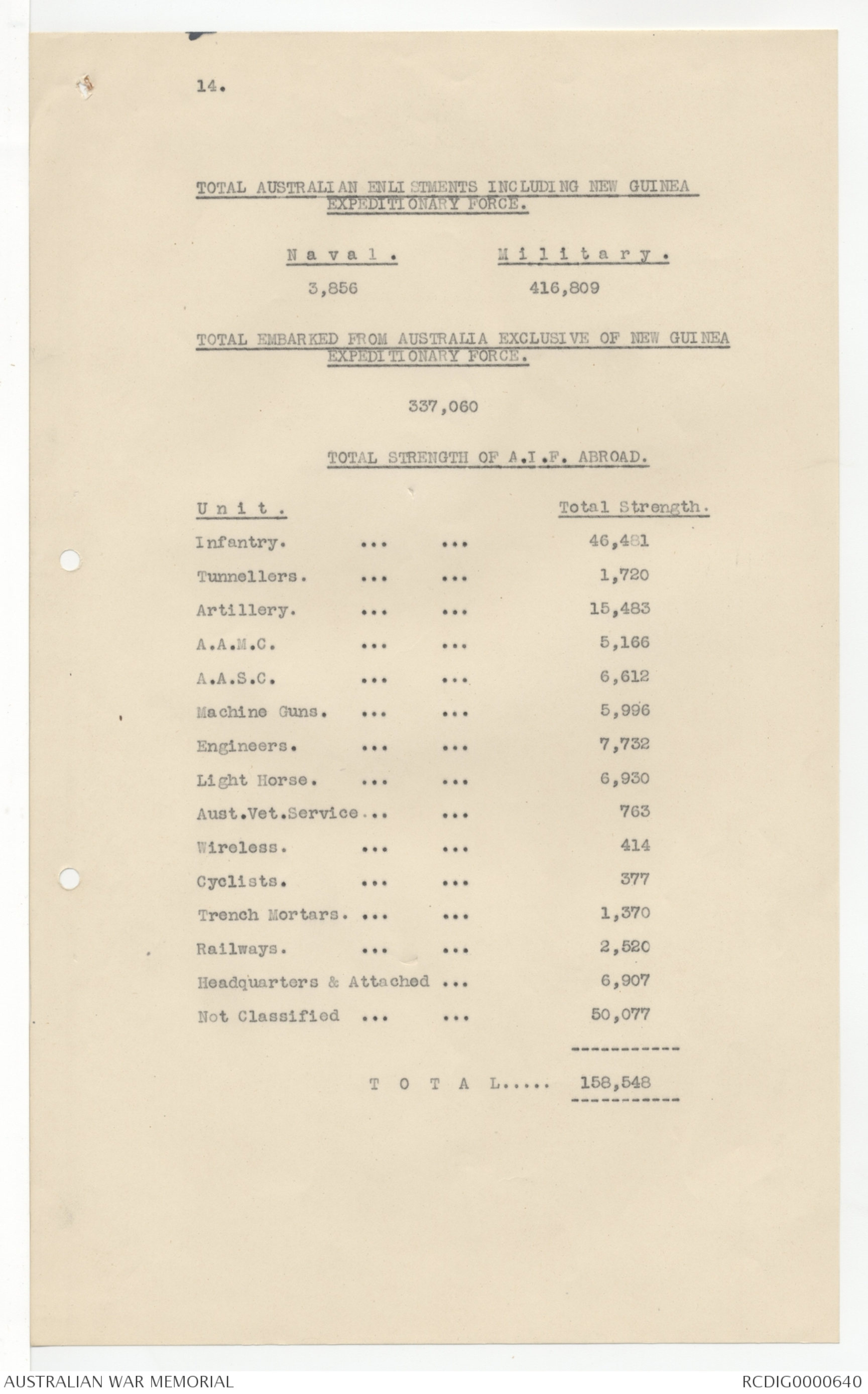
5.
13. The rates of pay in the A.I.F. are :-
| Pay and allowances. | |
| Colonel or Brigadier | £2/12/6 per diem. |
| Lieutenant Colonel. | 2/ 5/- “ “ |
| Major | 1/15/- " “ |
| Captain | 1/ 6/- " “ |
| Lieutenant, 2nd. Lieutenant | 1/ 1/- " “ |
| Regimental Sergt-Major. | 14/- " “ |
| Company Sergt-Major | 12/- " “ |
| Sergeant | 10/6 " “ |
| Corporal | 10/- “ “ |
| Air Mechanics | 8/- " “ |
| Privates. | 6/- " “ |
The payment of a portion (about one-sixth) of the
above rates is deferred until the soldier is discharged
from the A.I.F.
6.
18th. January, 1919.
PART III.
operations.
AUSTRALIAN NAVAL AND MILITARY EXPEDITIONARY FORCE.
At the outbreak of the war Australia was in a position
through its previous institution or compulsory training for
home defence, to mobilise a considerable number of men who
had had a greater or less amount of military training.
Though not under obligation for service abroad, a requisite
number of these men were immediately available, with the
aid of Australia's naval equipment, for the reduction and
occupation of Germany's colonial possessions in the Pacific,
Expeditions were sent for this purpose to:-
(a) The Bismarck Archipelago, under which name are
comprised the island of New Britain, New Ireland,
and various small islands, as well as the greater
part of New Guinea known as Kaiser Wilhelm's
Land.
(b) The Solomon Islands.
(c) The Marshall, Carolines, Pelew, and Ladrones
groups.
(d) And the operations of the Australian Navy cleared
the way for the occupation of the Samoan Islands
by forces from New Zealand.
Military and naval contingents from Australia captured
and hoisted the British flag in all these territories, and
some of them have since been administered by the Australian
Government with smoothness and efficiency.
AUSTRALIAN IMPERIAL FORCE.
The following is a short account of the operations of
the Australian Imperial Force by Mr. C. E. W. Bean, the
Australian Official War Correspondent.
GABA TEPE.
The first Australian and New Zealand Convoy for the war
in Europe consisted of an Australian Division (wisely named
7.
the 1st) the 1st Australian Light Horse Brigade, and the
New Zealand Infantry Brigade, and New Zealand Mounted Rifles
Brigade. The two forces have since grown into an army
larger than that originally despatched by Britain. The
British Authorities do not regard them as an Army but their
own countries do; they are an army in sentiment, and, to
that extent, in fact.
Within five months of sailing this new force, the
Australian and New Zealand Army Corps, under Sir William
Birdwood, was thrown against an appallingly difficult coast.
It seized a triangle of mountain-side - its main front on the
second ridge inland, its base on the beach. It held the
front through three long days, the 1st Australian Division
losing about half its strength, till the Turkish attacks wore
out. The position was called by the initial letters of the
Corps' name, - ANZAC. The support which the Australians
received, in these days of tremendous trial, from the
staunchness of the British Navy will never be forgotten by
those who went through them.
After the landing only one more offensive was made from
Anzac. The whole effort was concentrated at Helles, Two
Anzac Brigades - one Australian, one New Zealand - went to
Helles to reinforce. They formed the centre of the attack
on Krithia on May 8th, part of the 29th. Division, our old
comrades of undying memory, being on their left in the
attack. The Anzac troops lost half their reduced strength,
but reached and dug the "Redoubt"Line", where in eight
months only 500 yards more were gained.
AN IMMORTAL CHARGE.
The one offensive from Anzac, was made in August 1915
when the British landed at Suvla. It involved the
bloodiest fight Australians had fought, the taking of Lone
Pine, and the immortal charge of the Light Horse at the Nek.
8.
But the main offensive was that of the New Zealanders and the
4th Australian Infantry Brigade up the tangled Spurs of
Sari Bair. The New Zealand Mounted Rifle Brigade at
Hill 60 finished with 300 men. Towards the end of this
fighting a new Australian Division, the 2nd, arrived from
Egypt; but the offensive was finished; the campaign was
really closed. The decision to bring the troops back and
throw their weight into the Western Front was unquestionably
right. General Birdwood was given command of the Dardanelles
Army during the evacuation. Every man on the
Peninsula was transferred to reinforce Salonica, Egypt,
Mesopotamia, or France.
So Australians and New Zealanders wintered again in
Egypt, fortifying the canal, and in the hugh administrative
task of doubling their force. The old divisions were
split, new ones created from reinforcements accumulated in
Egypt. An Anzac Mounted Division was left in Egypt, and
has from that moment - from Katia to Jericho - been the
right hand of Egyptian defence.
The main army, the 1st and 2nd Anzac Corps, under
General Birdwood and General Godley, arrived in France between
April and June 1916. It had three quiet months in the line.
Then on July 19th one Australian Division, with a British
division, made an attack in the north near Fromelles; three
days later, in the south, the 1st Anzac Corps was launched
against the then main German position on the Somme, the
summit at Pozieres.
THE REAL TONIC.
Pozieres was the heaviest fight Australian troops had
fought. For a month it was the main centre of movement on
the Somme. Every German gun within range was concentrated
against the summit. The shell fire was appalling; but, by
fighting as heavy as has ever been, the German salient into
9.
the British line was converted into an Australian salient
projecting behind Thiepval. On September 5th when the
Australians left the Somme, the New Zealanders were going
in. In three separate attacks the New Zealand Division
reached every objective and more. They went from before the
Switch Trench to beyond Flers in a single morning, one of the
finest feats of the Somme. As they left the Somme, the
Australians returned to it, before Bapaume. In November,
this year's fighting ended in the heartbreaking mud of
Gueudecourt and the Butte.
In the mud the Australians and those beside them had to
winter. Their trials have never been written. The icy
bright weather relieved them, but the real tonic was the
discovery on February 24th, 1917, that the Germans were
retreating.
There followed heavy trench fighting before Bapaume and
Loupart Wood, but from Bapaume onward came the open. At
Beaumetz, Doignies, Louveral, Demicourt, Lagnicourt, Hermies,
Boursies, Noreuil, were sharp successful fights. The
Hindenburg Line was reached before the Germans intended.
Then, far on the flank of the Battle of Arras, on April
11th, an Australian Division was launched at the Hindenburg
Line near Bullecourt. The plan broke down, however, but
the infantry, by a miracle, got through. They were cut off
and many captured. On May 3rd the same sector was attacked
with full artillery and flank support. The latter failed
at first, but the line was taken and held against nearly
twenty counter-attacks, till a famous British Brigade
carried the trenches from the flank and made the position
secure. In June came Messines. The New Zealanders in
magnificient fettle, took Messines itself, with Australians
on their right. Other Australian troops held half of the
whole battle front, and were there till the battle finished.
10.
THIRD BATTLE OF YPRES.
In the autaumn of 1917 Australian divisions were engaged
as front line troops in the great push, by which the southern
part of the main ridge overlooking Ypres was taken, fighting
in the five pitched battles of the Menin Road, Polygon Wood,
Broodseinde, and the 1st and 2nd attacks near Passchendaele,
on September 20th September 26th, October 4th, October 9th
and October 12th.
On October 4th the whole Australian and New Zealand force
was for the first time fighting together in one soldid attack
or in close support. The fighting in these battles fell
very heavily upon the Artillery, and especially upon the field
batteries working in deep,mud under unceasing shell fire.
About this time the Australian Flying Corps entered the
struggle on the Western Front further south. Its first great
honour was really won in the magnificient flying incidental to
the sudden attack towards Cambrai in November 1917.
After spending the winter at Messines, Australian Divisions
were hurried down towards the end of March this year to
block the German advance towards Amiens. The Germans threw
themselves against this line on April 4th and 24th at Villers
Brettonneux, and on April 5th. at Dernancourt, but it was
held or re-established by magnificient counter-attacks.
Other Australians took part in blocking the German
advance upon Hazebrouck in the northern sector.
Added by the Australian War Records Section.
From March 28th, when the Australian divisions first
went into action and stopped the German advance on Amiens, to
the middle of July, by successive attacks they advanced the
corps front from 1,000 to 4,000 yards, took 3,000 prisoners,
2 field guns, and 450 machine guns and trench mortars, and
encountered and defeated 16 enemy divisions. 'The Australians
11.
in the Hazebrouck sector in the north were equally enterprising
and successful.
Australian divisions took part in the advance by
British and French troops which commenced on the 8th.
August. By the end of the first day they had advanced ten
miles, capturing 104 guns and many machine guns and trench
mortars, actually they had reached this line a little after
midday. On the second day they advanced their line from
the furthest point reached on the first day another five
miles on the southern flank and from one to two miles on the
northern flank. On the fourth day they took Lihons; they
were driven out by a German counter-attack, but within 2½
hours had restored the line.
During these operations they advanced a total of about
13 miles on a nine mile front, took 8,000 prisoners and about
120 guns.
THE CAMPAIGN IN THE EAST.
In the East, Australian troops have been continuously
fighting in the defences of Egypt and the Suez Canal, and
later in the expedition into Palestine now proceeding.
The fall of Beersheba, which was brought about by a
sudden movement of Anzac Mounted troops, was the beginning
of the rolling up of the whole Turkish line. The details
of Romani, Rafa, Beersheba, and the wild desert and mountain
fighting which followed, are little known as yet; but they
will form one of the most brilliant and romantic episodes
in the history of the war.
12.
18th. January. 1919.
PART IV.
MUNITIONS, WAR CHARITIES, &C.
1. Since the outbreak of war the Australian Government
has actively participated in supplying munitions of war.
The factories established before the war for the manufacture
of explosives, ammunition, small arms, clothing
harness, etc. have been enlarged and subsidised and their
output greatly increased.
In addition, Australia is sending at her own expense,
operating hands, comprising skilled and unskilled workmen,
for war-work in Great Britain. The number already sent is
about 3,000.
2. The people of the Commonwealth have by voluntary
subscription, contributed several millions sterling to
various funds raised either for the relief of the smaller
allied nations, for the Red Cross, (including a very large
donation to the French Red Cross), the relief of prisoners
of war or similar purposes.
3. Australia has organised and arranged for financing
a complete scheme for the repatriation and resettlement
of her soldiers and their dependents, and provision for
the dependents of deceased soldiers. The scheme also
provides for the training in suitable trades, or setting
up in business, with interim maintenance, of the partially
incapacitated, and living pensions for the totally incapacitated
and maintenance when required of their familes. For
these purposes £32,000,000 has already been set aside, and
the States have provided several millions of pounds worth
of land for rural settlement.
The details of an education scheme for the benefit of
serving soldiers, especially during that period following
the cessation of hostilities while they are awaiting their
return to Australia and during the outward voyage, are
13.
being worked out at present.
14.
TOTAL AUSTRALIAN ENLISTMENTS INCLUDING NEW GUINEA
EXPEDITIONARY FORCE.
Naval. Military.
3,856 416,809
TOTAL EMBARKED FROM AUSTRALIA EXCLUSIVE OF NEW GUINEA
EXPEDITIONARY FORCE.
337,060
| TOTAL STRENGTH OF A.I.F. ABROAD. | |
| Unit. | Total Strength. |
| Infantry. | 46,481 |
| Tunnellers. | 1,720 |
| Artillery. | 15,483 |
| A.A.M.C. | 5,166 |
| A.A.S.C. | 6,612 |
| Machine Guns. | 5,996 |
| Engineers. | 7,732 |
| Light Horse. | 6,930 |
| Aust. Vet. Service. | 763 |
| Wireless. | 414 |
| Cyclists. | 377 |
| Trench Mortars. | 1,370 |
| Railways. | 2,520 |
| Headquarters & Attached | 6,907 |
| Not Classified | 50,077 |
| TOTAL | 158,548 |
 Sam scott
Sam scottThis transcription item is now locked to you for editing. To release the lock either Save your changes or Cancel.
This lock will be automatically released after 60 minutes of inactivity.